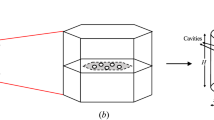Abstract
Stress corrosion cracking (SCC) is commonly observed to form a colony of closely spaced multiple cracks. Four stages of SCC colony evolution are discussed. The first is the colony initiation stage (CIS), which is associated with formation of corrosion pits randomly distributed over a certain domain of the surface exposed to an aggressive environment. Electrochemical processes play a leading role in CIS. The individual crack growth (ICG) driven by a combination of mechanical stresses and electrochemical processes constitutes the second stage. At the end of the second stage, the individual cracks reach certain proximity of one another resulting in much crack interaction. This becomes a transition to the third, strong crack interaction and clusters formation, stage. Cluster growth and individual crack or a cluster instability leading to the ultimate failure constitute the final, fourth stage of the SCC evolution process. In this article, we present observations and a general approach to modeling the first two stages of SCC, i.e., CIS and ICG, that together constitute the major part of the total lifetime of an engineering structure serving under SCC conditions. A computer simulation of individual SC crack growth is developed and compared with a large set of SCC observation data.















Similar content being viewed by others
References
B. Zhang, J. Fan, Y. Gogotsi, A. Chudnovsky, and A. Teitsma: Proc. 4th Int. Symp. on Risk, Economy and Safety, Failure Minimization and Analysis, Umhlanga Rocks, South Africa, July 2000.
A. Chudnovsky, Y.G. Gogotsi, B. Zhang, S. Hirnyj, J. Fan, and T.J. Kirchhartz: GRI Report No. GRI-99/0163, Gas Research Institute, Des Plaines, IL, 1998.
B. Zhang, Y. Gogotsi, A. Chudnovsky, and A. Teitsma: Proc. 1998 Int. Gas Research Conf., San Diego, CA, Nov. 1998, pp. 607–17.
B. Zhang, J. Fan, Y. Ying, B.-H. Choi, A. Chudnovsky, and A. Teitsma: Proc. 2001 Int. Gas Research Conf., Amsterdam, Netherlands, Nov. 2001.
C.K. Eilerts: Industrial Eng. Chem., 1949, vol. 41, pp. 1716–17.
A. Chudnovsky: NASA Contractor Report No. 174634, Cleveland, OH, Mar. 1984.
J.A. Beavers and J.T. Johnson: PRC International Annual Report No. R283-01, Dublin, OH, May 1999.
B.-H. Choi and A. Chudnovsky: Int. J. Fract., 2002, vol. 116, pp. L43–L48.
TransCanada Pipelines: Report on 1987 Pipe Integrity Program, SCC Research Program and Planned 1988 SCC Research Program, Calgary, 1988.
M. Elboujadaini, Y.-Z. Wang, and R.W. Revie: Proc. 2000 Int. Pipeline Conf., ASME, New York, NY, Oct. 2000, vol. 2, pp. 967–78.
C.-S. Oh and Y.-J. Kim: Proc. KSME Fall Conf., KSME, Seoul, Republic of Korea, Nov. 2007, pp. 69–73.
H. Jasarevic, A. Chudnovsky, J.W. Dudley, and G.K. Wong: Int. J. Fract., 2009, vol. 158, pp. 73–80.
W.A. Weibull: J. Appl. Mech., 1951, vol. 18, pp. 293–97.
B.G. Ateya and H.W. Pickering: J. Electrochem. Soc., 1975, vol. 122, pp. 1018–25.
O.N. Romaniv and G.N. Nikiforchin: Metallurgiya, Moscow, 1986.
R.P. Wei and J.D. Landes: Mater. Res. Standards, 1969, vol. 9, pp. 25–36.
R.P. Wei and L. Gallaher: Corrosion Fatigue: Chemistry, Mechanics and Microstructure, NACE-2, Houston, TX, 1972, pp. 396–408.
C.P. Austin and J. Walker: Corrosion Fatigue: Chemistry, Mechanics and Microstructure, NACE-2, Houston, TX, 1972, pp. 424–36.
D. Rhodes, J.K. Musuva, and J.C. Radon: Fatig. Fract. Eng. Mater. Struct., 1981, vol. 4, pp. 49–63.
R.N. Parkins, W.K. Blanchard, and B.S. Delanty: Corrosion, 1994, vol. 50, pp. 394–408.
B.-H. Choi, A. Chudnovsky, R. Paradkar, W. Michie, Z. Zhou, and P.-M. Cham: Poly. Degrad. Stabil., 2009, vol. 94, pp. 859–67.
J.D. Eshelby: Philos. Trans. R. Soc. A, 1951, vol. 244, pp. 87–112.
J.D. Eshelby: J. Elasticity, 1975, vol. 5, pp. 321–35.
Y.E. Pak and G. Herrmann: Int. J. Eng. Sci., 1986, vol. 24, pp. 1365–74.
S. deGroot and P. Mazur: Non-Equilibrium Thermodynamics, Dover Publications, Mineola, NY, 1984.
I. Prigogine: Introduction to Thermodynamics of Irreversible Processes, Interscience Publishers, New York, NY, 1968.
B.-H. Choi, W. Balika, A. Chudnovsky, G. Pinter, and R.W. Lang: Poly. Sci. Eng., 2009, vol. 49, pp. 1421–28.
Acknowledgment
The authors express deep gratitude to Ilhyun Kim and Yongjian Zhao for their technical help.
Author information
Authors and Affiliations
Corresponding author
Additional information
Manuscript submitted January 28, 2010.
Appendix A
Appendix A
1.1 Representation of the concentration of hydrogen at the crack tip
The distribution of the concentration of hydrogen, C(x, t), satisfies the diffusion equation
The vector flux of hydrogen is \( \underset{\raise0.3em\hbox{$\smash{\scriptscriptstyle-}$}}{q} (x,t)_{|x = 0} = \underset{\raise0.3em\hbox{$\smash{\scriptscriptstyle-}$}}{q} (t) = \underset{\raise0.3em\hbox{$\smash{\scriptscriptstyle-}$}}{q} \cdot \underset{\raise0.3em\hbox{$\smash{\scriptscriptstyle-}$}}{e}_{1} , \) and the boundary and initial conditions are defined as
where C max stands for the saturated hydrogen density and the coefficient k depends on the stress ratio and time. In addition, the solution of Eq. [A1] can be expressed as a standard form:
We can define C(0, t) = C 0(t); thus, Eq. [A3] represents the shape of the distribution in time. Green’s function for density C(x, t) due to unit mass concentrated at (ξ, τ) can be represented as
For τ domain and x = 0, i.e., hydrogen diffused only from the crack tip,
where
Plugging Eq. [A6] into Eq. [A5] leads to
Plugging Eq. [A7] into Eq. [A6] leads to
For \( \left. {C(x,t)} \right|_{x = 0} = C_{0} (t), \) Eq. [A8] can be rewritten as
So, Eq. [A9] can be expressed as an integral equation as
Equation [A10] is a known special kind of integral equation, i.e., Volterra type of the second kind, so Eq. [A10] can be solved by using Laplace transforms and inverse Laplace transforms. The solution of the integral equation is as follows:
Finally, Eq. [A11] can be expressed simply as
The general solution of C(x, t) can be obtained by plugging Eq. [A12] into Eq. [A8] as follows, and can be solved by numerical approaches:
Rights and permissions
About this article
Cite this article
Choi, BH., Chudnovsky, A. Observation and Modeling of Stress Corrosion Cracking in High Pressure Gas Pipe Steel. Metall Mater Trans A 42, 383–395 (2011). https://doi.org/10.1007/s11661-010-0384-2
Published:
Issue Date:
DOI: https://doi.org/10.1007/s11661-010-0384-2




